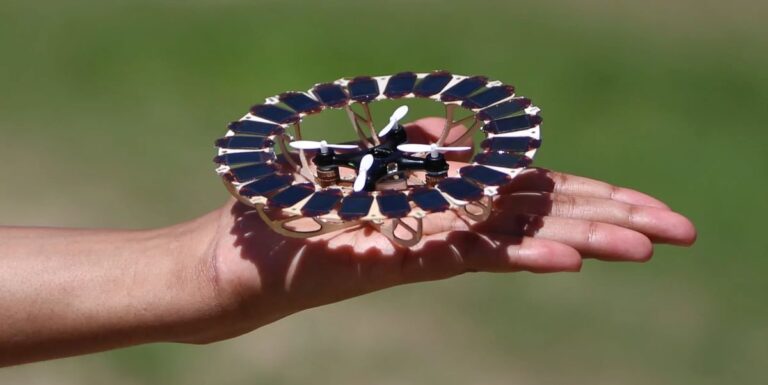An Austrian research team has demonstrated lightweight, flexible and ultra-thin perovskite solar technology in palm-sized autonomous drones, demonstrating the technology’s stability and energy harvesting potential. The single-junction champion cell in the study had an open-circuit voltage of 1.15 V and an efficiency of 20.1%.
A team from Johannes Kepler University Linz has developed lead halide perovskite solar cells less than 2.5 μm thick, with a champion-specific PV power density of 44 W/g and an average performance of 41 W/g, which they were able to integrate into modules to power quadcopter-like drones the size of a palm.
The technology showed promising stability results during several standard tests, as well as energy harvesting potential sufficient to charge the vehicle’s batteries. The details of their research appear in “Flexible quasi-2D perovskite solar cells with high specific power and improved stability for energy autonomous drones,” published in nature energy.
The study’s large-area 24 cm2 photovoltaic module enabled autonomous drone operation beyond what is possible on a single battery charge, while eliminating the need for docking, connected charging or other forms of human intervention .” The perovskite solar panels contributed only 1/400th of the drone’s total weight.
The group tested different alpha-methylbenzyl ammonium iodide (MBA) combinations in the top perovskite absorber layer, where PEDOT:PSS combined hole transport and electrode functions. The longest-lived among the different MBA formulations included cesium (Cs), indicating “a reduction in non-radiative recombination pathways due to the presence of MBA and Cs,” the researchers said.
The substrate was an “ultra-thin” and transparent conductive oxide-free 1.4 μm thick polymer film covered with a 100 nm layer of aluminum oxide. It served effectively as a “barrier” against moisture and gases.
“This type of device does not accommodate typical encapsulation approaches, which are simply too thick. Instead, the team relied on the large, bulky crystal formation of the MBA’s perovskite top layer to effectively passivate the surface, and for the substrate, the alumina layer applied with atomic layer deposition (ALD) tool serves to protect against the external conditions, but yet remain light and flexible,” says research leader Martin Kaltenbrunner pv magazine.
For example, the article notes that the water vapor transmission rate (WVTR) of the “coated ultrathin substrate was approximately 35% lower” compared to the reference designs, which were methylammonium lead iodide (MAPbI3) devices.
Other features of the perovskite cell include an electron transport layer made of phenyl-C61 butyric acid methyl ester (PCBM) with a titanium oxide interlayer, and a metal top contact, which the group indicated could be interchangeably made of gold or chromium. /gold, or cheap aluminum.
“It is important in our perovskite solar research to use precursors that are synthesized in as few steps as possible. An uncomplicated synthesis is crucial because we want the technology to be scalable and keep the production costs of materials under control,” says Kaltenbrunner.
From cells to modules
The small area perovskite solar cell had a size of 0.1 cm2 with an open circuit of 1.13 V, a short circuit current density of 21.6 mA cm−2, a fill factor of 74.3% and an energy conversion efficiency of 18, 1%. The champion cells achieved an open-circuit voltage of 1.15 V, a fill factor of 78% and an efficiency of 20.1%.
The larger device had an active cell area of 1.0 cm2, with an average open-circuit voltage of 1.11 V, a short circuit density of 20.0 mA cm−2, a fill factor of 65.9%, and an efficiency of 14.7. The champion device achieved an efficiency of 16.3%, the research team said.
The module for powering the drone consisted of 24 interconnected solar cells of 1 cm2. The energy-autonomous hybrid solar-powered commercially available quadcopter-type drone weighed only 13 g.
Stability and long-term outdoor usability were tested. For example, both the small and large area unencapsulated solar cells retained 90% and 74% of initial performance, respectively, after 50 hours of continuous maximum power point tracking (MPPT) in ambient air. In addition, an external laboratory has validated the performance and properties of the perovskite composition.
The team claimed to have demonstrated “the broader benefits of using a quasi-2D perovskite active layer” and that it outperforms “other compositions in this area,” adding that the performance, stability and usability of the ultralight perovskite solar technology are unparalleled. both a “portable and cost-effective solution for harvesting sustainable energy”.
As a drone charging system, it is a step towards ‘perpetual-operation vehicle development’ for both space and land applications, the report states.
The team has plans for further research along these lines. “We will continue to work on developing AlOx barrier substrate technology and scalable deposition techniques, and on scaling up to even larger modules of at least 10 cm x 10 cm. We are focused on developing lightweight, flexible PV solutions to power all kinds of robotics and autonomous vehicles,” said Kaltenbrunner. “There is great potential for deployable, flexible solar energy in both terrestrial and space applications.”
Image: JKU
This content is copyrighted and may not be reused. If you would like to collaborate with us and reuse some of our content, please contact: editors@pv-magazine.com.


